Peyote or mescaline art is a visual styling that resembles luminous oto-visual emissions, phosphenes, or entoptics. However these artworks also contain the universal subconscious standard structure of visual expression, named mindprint (Furter 2014). Here are some examples, in addition to another post on www.edmondfurter.wordpress.com. And some artworks by Dali, and rock art of aloe ferox laxative, for comparison. Art does not come from drugs, or constellations, or trance (see a discussion below the examples).
A cave of mystery and a Basket Lid
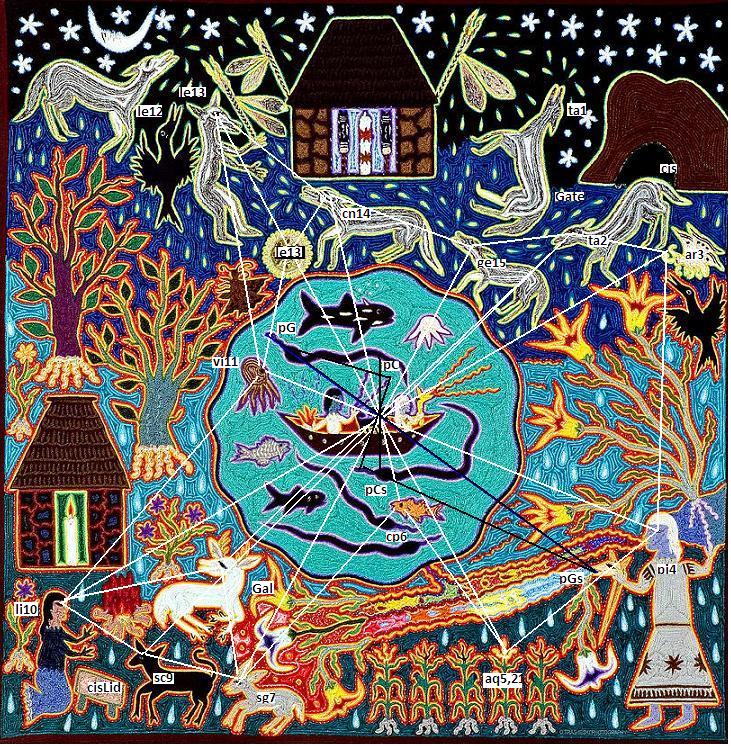
The types are marked by the standard set of numbers, and their cosmology counterparts; and by the standard subconscious axial grid between their eyes (with the two standard exceptions to the 12/13 Leo heart, and the 11 Virgo womb).
A NOTE ON TYPE LABELS: Illustrations in this post use the initial cosmology labelling format as in the book Mindprint, after analogous constellations, and archetypal numbers, for example Ta2, Ar3, Pi4. Since 2018, archetypal structuralist analysis uses the same numbers, but with generic social functions, for example 2Builder, 3Queen, 4King, etc, to better demonstrate that nature, culture and all media, symbols, icons and meaning itself, express archetype, and not any particular expression or media of archetype. The sky, and the myths we allocate there, also express archetype. Captions in this post note generic as well as cosmic labels.
Type labels; Characters in a Frasheski mescaline-style textile work (noting archetypal features):
02 Builder or Taurus; Wolf (more typical of type 15 adjacent, just preceding 1 /2 in the cycle), twisted (twisted).
02c Basket; Mountain cave (see alchemical, Rosicrucian, and Hopi art in another post).
03 Queen or Aries; Butterfly with ‘eyes’ on long bent feelers (more usually long or bent neck). Next to a bird with a long neck as ‘determinant’.
04 King or Pisces; King (king) or healer?, rectangular (rectangle).
05 Priest or Aquarius; Lumiated maize seed head (NO EYE).
06 Exile or Capricornus; Fish (a rare feature here), near the centre (ingress), wet tail (decan Capricornus tail).
07 Child or Sagittarius; Juvenile (child) animal.
09 Healer or Scorpius; Wolf (canid), bent tail.
09c Basket Lid; Chest or altar or basket (container, secret).
10 Teacher or Libra; V-posture (arms up).
11 Womb or Virgo; Octopus abdomen (womb).
13 Heart or Leo; Wolf-man, and a rosette centre (interior, concentric).
14 Mixer or Cancer; Wolf (small canid or felid). Decan Lynx is shared with type 15.
15 Maker or Gemini; Wolf (canid).
Numbering of the labels is necessary because some artworks split each of the four ‘large’ types into two (1 /2 Builder or Taurus, v 8/9 Healer or Scorpius; 5a/5b Priest or Aquarius, v 12/13 Heart or Leo. The number 5 is repeated, since archetypal numbers follow octal base9, not decimal base9. The next magnitude level of archetype resolves 5a:20 and 5b:21. This artwork expresses only one each of the four ‘beasts’, thus the 1v8 and 5a,v12 axes are in ‘reserve’, just as some genetic material is ‘recessive’.
Compare the subconscious mindprint in this artwork with some subconscious mindprints in other art and rock art works, posted on www.edmondfurter.wordpress.com.
The range of recurrent features, their sequence, their individual average frequencies, the axial grid between eyes, and the polar structure, is the subconscious standard of cultural expression, indicating archetype itself, which could be known only through its expressions, as Plato explained in his Cave analogy (Furter 2014; Mindprint.)
See the structure in some ayahuasca art by Pablo Amaringo, with the invariable mindprints marked out, in Furter 2014; Mindprint (Lulu.com). There are three or four examples in similar ‘dayglow’ styling, among the 200 illustrations from every known culture, in the book. Some Ice Age, Gobekli Tepe, Renaissance, rock art, and modern examples are in my papers in the anthropology journal Expression, and in two articles on http://www.Grahamhancock.com (one under Author of the Month, the other on the stoneprints in the Rennes le Chateau landscape),
Dali as Angel of Time

The types are subconsciously expressed by optional features, and by the axial grid between their eyes (with two standard exceptions, to the 11 Womb or Virgo, and 12/13 Heart or Leo), in their standard sequence, here in the seasonal direction instead of the numerical or hours direction. Artists subconsciously use either direction.
Type label; Character (noting archetypal features);
01 Builder or Taurus; Hero twisted (twisted), sometimes a female ‘Perseus’ or gorgon.
03 Queen or Aries; Banner (see Agnus Dei banners, a rare feature globally), on a foot (NO EYE, or displaced to the long-necked giraffe at 10 opposite).
04 King or Pisces; Brown pigeon.
05a Priest or Aquarius; Blue (varicoloured) pigeon (angel).
05b Priest or Aquarius; Spider, colourful (varicoloured).
06 Exile or Capricornus; Needle point or ‘eye’ (NO EYE).
07 Child or Sagittarius; Fly (unfolding?).
09 Healer or Scorpius; Giant (large) bug (healer?).
10 Teacher or Libra; Bee, wings in V-posture (arms up). And giraffe with eyes on ears in V-posture (arms up).
11 Womb or Virgo; Abdomen (womb) of headless woman in bowl.
12 Heart or Leo as a monkey, and decapitated head (invert).
13 Heart or Leo; Ball or chest (heart).
14 Mixer or Cancer; Salvador Dali on a flowing clock face (time. See Tarot trump 14, Temperance).
15 Maker or Gemini; Skull (skull) or white face (face), its body holding a syringe as a mace (mace). And a monkey twisted (twisted).
Axial centre; Unmarked as usual, on the absent hand of the statue.
11p Galactic pole; Monkey hand (limb joint).
4p Galactic south pole; Statue hip (limb joint).
Midsummer; Unmarked.
Midwinter; Rock ‘limb joint’.
The vertical plane confirms these polar triangles (marked in black lines), placings midsummer between axes 14-15 or Cancer-Gemini, thus spring and the time-frame in Age Aries-Pisces, typical of religious art of the last 2100 years. Aries itself is not expressed, unusually, perhaps displaced to the syringe as a kind of cross (sacrifice).
Compare the subconscious mindprint in this pseudo-Dali styling, with some more Dali paintings on www.edmondfurter.wordpress.com and with other artworks and rock art works. The range of frequent features, their sequence, the axial grid between eyes, and the polar structure, is a subconscious standard of cultural expression (Furter 2014; Mindprint.)
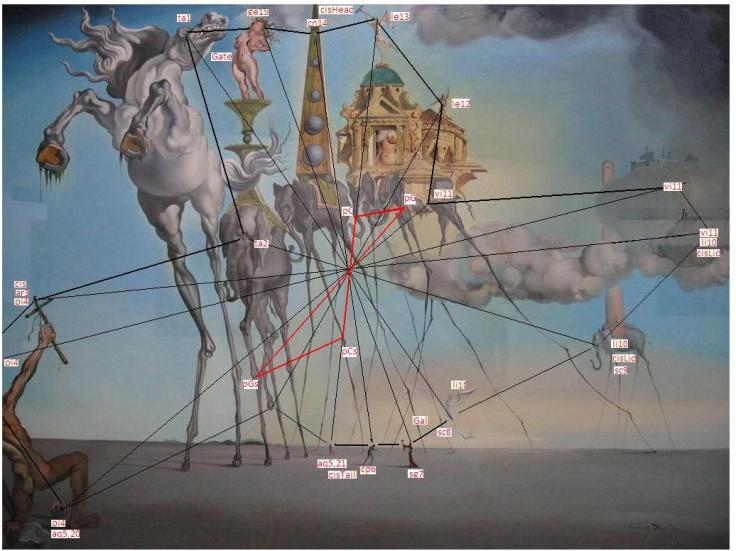
[….. All the standard types are expressed, by some of the optional features of the types; in their usual peripheral sequence; on the usual ocular axial grid; with the usual polar structure.]
When typological features in any random collection of 50 or more artworks are added up and converted to percentages, they conform to percentages as listed in the book, Mindprint, and in Stoneprint, and expanded and updated in 2019 editions of Stoneprint Journal. Thus even the frequencies of the most common options (such as 9 Healer or Scorpius bent forward, 11 Womb or Virgo womb, 15 Maker or Gemini rope, or impact weapon, 12 /13 Heart or Leo heart, or felid; and many more), are predictable in collections of artworks within the reach of manual statistics.
The three layers of visual structure are too complex for artists to express consciously. No trace of recognition of the structure of culture could be found prior to publication of the book Mindprint in 2014 (demonstrating 200 expressions in illustrations, and listing 400 in the index). Peyote art, mescaline art, rock art, ‘fine’ or academic art, and political art, of every culture, continent and region, contain the same structure, hidden in plain sight, invisible until demonstrated by a pencil, a ruler, and a list of about 100 inter-dependent features. Most complex artworks, even by novice artists, express about 60 of the currently known features.

An ark and covenant mother
Type 11 Womb or Virgo as the womb of a polar woman, her navel expressing type 11p Galactic Pole (Salvador Dali; Spain, or Ampurdan Plain. Typology labels and axial grid by E Furter). Characters seem to emerge from a chest of drawers in the 9c Basket Lid (container, revelation) sector, inverting the ark theme where figures enter a box, typical of the 2c or Basket sector. The Spain woman’s rectangular chest or drawers echoes the opposite buildings on a dusty street, above sector 5c or Basket Tail, near type 5 Priest or Aquarius and 4 King or Pisces (often rectangular), analogous to decan Pegasus (which is often a horse, pond or field grid). Here Spain’s Ampurdan Plain is gridded by field lines (top left).
Plains are always more alive than meet the eye. Type 10 Teacher or Libra is a see-saw rider, the concept of balance as turner of the wheel of life, doubling as nipples on the transparent breasts that overlay the landscape as the body of the beloved land.
A celestial pole on a rider’s hand tag the inspiration as Age Taurus-Aries, incidental with the conscious theme of passing events and evaporated time.
Balance of nature and culture
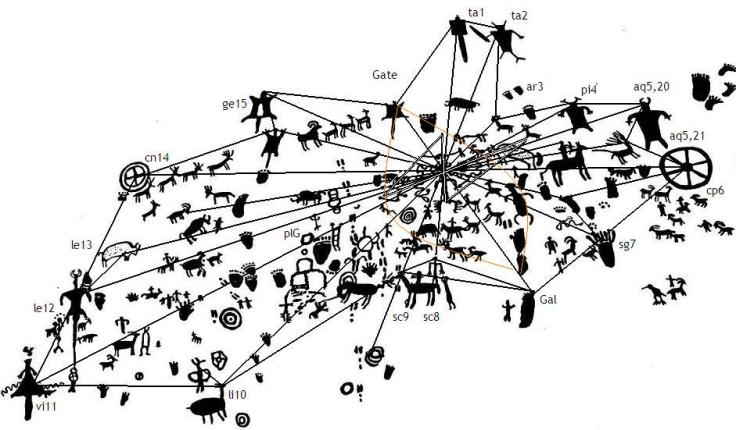
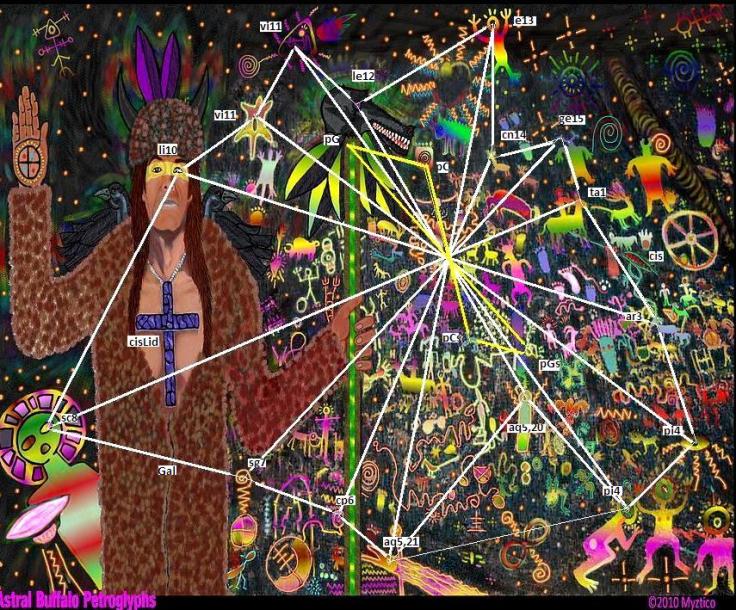
Eyes of the types are on the usual subconscious axial grid, with the usual two exceptions to the 11 Womb or Virgo, and 12/13 Heart or Leo; in their standard sequence.
Type label; Characters in a Myztico work (noting archetypal features):
01 Builder or Taurus; Animal, twisted? tail, near a rainmaker?
03 Queen or Aries; Goat (more usually ovid).
04 King or Pisces; Eye.
04 King or PiscesB; Rectangular (rectangle), squatting (squat). Doubling of type 4 is unusual.
04p Gal.S.Pole; Hip (limb joint) and a small figure’s foot (limb joint).
05a Priest or Aquarius; Rectangular (of 4, or here as decan Pegaus).
05b Priest or Aquarius; Coloured (varicoloured) water beast (water, horizontal).
06 Exile or Capricornus; Bag on rope (displaced from 7), wet tail (decan Capriconus tail knot, of 5c).
07 Child or Sagittarius; Rope (rope) over bag (bag).
08 Healer or Scorpius; Leaning (bent?), large (large).
09c Basket Lid; Cross (more often a disc, here displaced to type 8).
10 Teacher or Libra; Teacher (school), arms in W-posture (arms up), staff (staff), nature-culture (balance).
11 Womb or Virgo B; Geometric figure’s abdomen (womb). Doubling of this type is unusual but not unique. See several type 11 aces in London, in Stoneprint Journal 4).
11 Womb or Virgo; Animal skin with abdomen mark (womb).
11p Galactic Pole; A head-staff (juncture or limb-joint).
12 Heart or Leo; Wolf (more usually felid), decapitated (invert), spiked.
13 Heart or Leo; Man hyperactive (of 5 opposite).
14 Mixer or Cancer; near the centre (ingress), small (small).
15 Maker or Gemini; With a rope (rope), two-headed (doubled), near his double (doubled).
Axal centre; Limb joint?
Midsummer; Footprint (juncture or ‘limb-joint’), near the vertical plane (orientation) of some of the pseudo rock art characters. These markers place ‘midsummer’ between axes 12-13 or Leo12-Leo13, thus ‘spring’ and the cultural framework in Age Taurus1-2, typical of alchemical art in all ages.
Compare this subconscious mindprint, with the subconscious mindprint in the large rock art engraving panel from which some of the semi-geometric figures are copied (above the peyote artworks, and in more detail on www.edmondfurter.wordpress.com), and with a subconscious Chinese Tien Shan range rock art engraving (adjacent to the American engraving on that web page, and in the book). The range of frequent attributes, their sequence, the axial grid between eyes, and the polar structure, is a subconscious standard of cultural expression (Furter 2014; Mindprint.)
All art is art
Mescaline styling is recognisable in some rock art loosely labelled ‘trance art’. The style is named ‘pseudo’ rock art if the artist copies a recognisable rock art styling. There should be no distinction between ‘taught /untaught’, or trance /conceptual, or ‘own /borrowed’ culture, styling or media, since all art is art. It is impossible to ‘fake’ structural expression, and thus it is a kind of hallmark of inspiration.
Merry Christmas and a happy Age Aquarius

In 2014 I found Bannon’s retro-styled artwork and made a Christmas card of it. The usual structuralist analysis demonstrates the standard but subconscious mindprint typology sequence, and the usual lines to reveal the ocular (eye to eye) axial grid, and ‘polar’ triangles. Whether the work is a copy of a rock art panel, or a modern work, is immaterial to archetypal expression. This artwork was one of many tested after the book Mindprint, that confirmed that the structure applies to all artworks, of all cultures, and predicts the core content of newly found ancient works, as well as future artworks.
I emailed the analysis to some archaeologists, anthropologist, artists, and drumming circle members, and received mixed responses. Most people are still not consciously aware of the role of archetypes in nature, perception, or behaviour. Popular culture and sciences, even anthropology and psychology, have a blind spot, or layers of blind blots, for archetypes.
Type 15 Maker or Gemini as two Rope People (rope), resemble a trio of type 15 character in a South African San (Bushman) rock art panel, nicknamed ‘Vapour trails’, where their ‘sky ropes’ (a recognised archaeological term) are attached to the back of their spines (see Tarot trump 15 versions with two souls roped to a worldly creator or daemon, usually unnamed, or labelled ‘Devil’.)
Tribeways drumming circle uses mescaline art in its advertising, which I added to the growing number of analyses, in further proof that all cultures and styles speak a collective visual language.
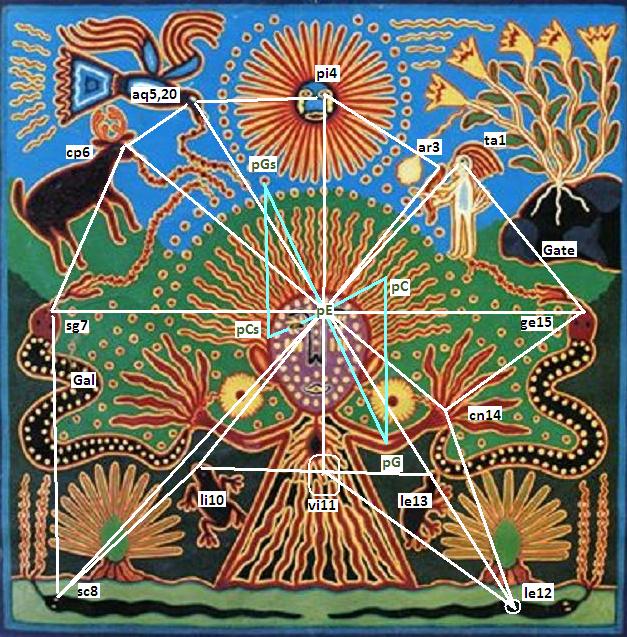
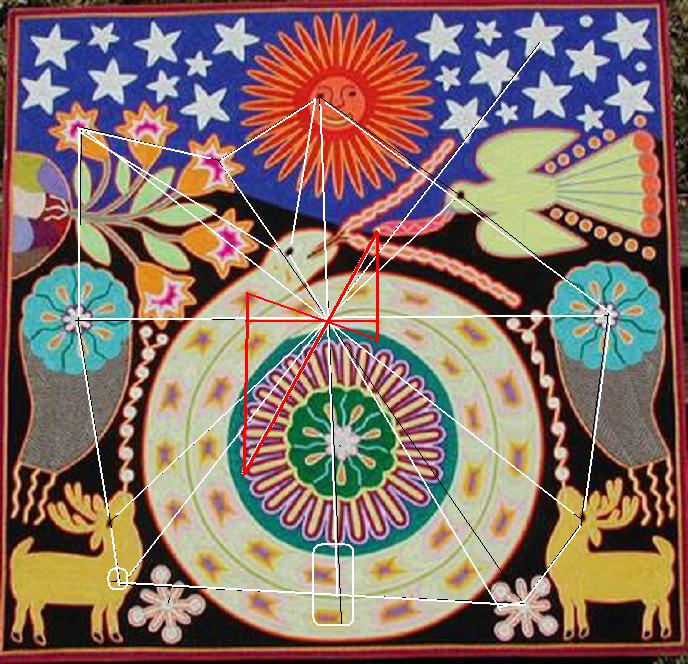
Clues; Type 3 Queen or Aries has a long or bent neck in 42% of artworks;
Type 15 Maker or Gemini has or is a rope (33%) or bag (21%), or both. Its ‘magnitude’ is type 0 (zero), corresponding to Tarot trump zero, Fool with a bag;
Type 13 Heart or Leo is on a heart (85%);
Type 11 Womb or Virgo is on a womb (87%);
Type 7 Child or Sagittarius is a bag (25%), sometimes with a rope, and/or juvenile;
Type 4 King or Pisces is sometimes a sun. Its higher magnitude is 4:19, as in the number of Tarot trump 19, Sun.
Structuralist anthropology and iconography research reported in Mindprint, and Stoneprint Journal, incidentally revealed details of the cosmological division of ecliptic (constellation) divisions, that allowed a calculation of the date of the Age Pisces to Age Aquarius transition, by the exact positions of the four seasonal points and the exact borders of archetypal constellations. That date is 2016, when the spring-autumn points were on two Pegasus stars and the Cetus spout; and solstice points were on the galactic gates (Furter 2014; Mindprint. Lulu.com). However artists are not consciously aware that some of the secondary or incidental detail in the holographic structure that anchors their visual expression, also expresses a cosmic and precessional temporal framework. This clock of ages could not be used to date artworks, since most artists express inspiration framed by the previous age, or one of the previous ages, of varying length, during which precession moved at slower rates (see a post on http://www.stoneprintjournal.wordpress.com for a discussion of the problems inherent in assumptions of precessional metrics, obliquity, and the Newcombe curve).
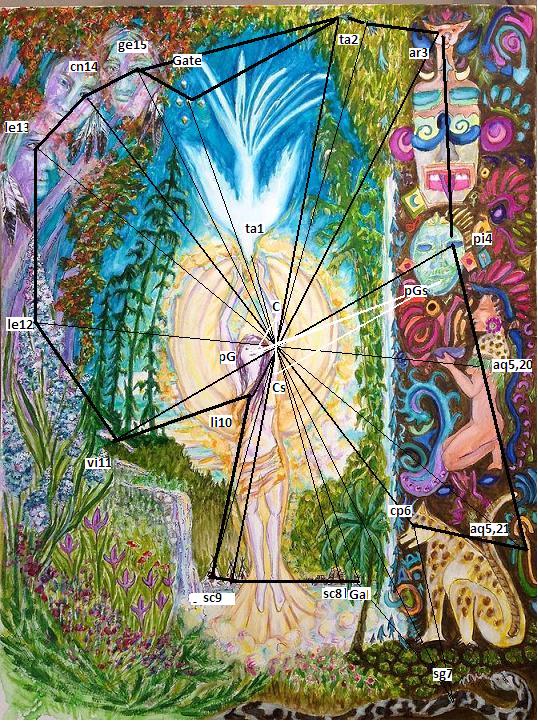
Marsha Walker; Where spirit meets goddess. Cosmology labels and axial grid by E Furter 2015.
Type label; Character (archetypal features):
01 Builder or Taurus; Swallow or swift-person (bird, swift-person).
02 Builder or Taurus; ? and ? (cluster. Their opposites at 9 are also indistinct).
03 Queen or Aries; Long-necked animal icon (long neck), topping a mask.
04 King or Pisces; Large mask (more typical of 15).
04p Gal.S.Pole; Mask jaw (limb joint, a frequent polar marker).
05a Priest or Aquarius; Chest (heart, of 12 opposite) of a priest (priest).
05b Priest or Aquarius; Chest (heart) of a geometric character.
06 Exile or Capricornus; Coyote? (more often caprid), near the centre (ingress).
07 Child or Sagittarius; Snake skin (bag), NO EYE, but lack of an eye is not penalised at type 7, since it is often a bag.
7g Galactic Centre; Palm-tree top (juncture).
08 Healer or Scorpius; Hut.
09 Healer or Scorpius; ? and ? (their opposites at 2 are also indistinct).
10 Teacher or Libra; Central character’s chest (heart, unusual at type 10). Some elements hint at overwork or re-work of the design, as found in the artworks of William Blake, Poussin, and a few other esoteric artists.
11 Womb or Virgo; Salmon abdomen (womb), swimming upstream to spawn.
11p Galactic Pole; Central woman’s jaw (limb joint, a frequent polar marker).
12 Heart or Leo; American Indian warrior’s chest (heart).
12 Heart or Leo; American Indian warrior (war).
14 Mixer or Cancer; American Indian woman.
15 Maker or Gemini; American Indian person.
15g Gate; Five dots (juncture).
Test your own artwork, or your own art analysis
These ‘peyote’ artworks are from a quick internet search. I downloaded the first six works containing eleven or more characters. They all express the five layers of mindprint structure, with the usual apparent variation and pleasant surprises, while remaining true to archetypal ‘grammar’ or ‘DNA’.
Artworks with less than eleven characters (people, animals, geometric figures, etc), usually express only some of the sixteen types, and are difficult to prove as typological, since some lack axial opposites, and minimal or ‘sparse’ artworks lack the full and complex context of multiple points of evidence, and axial geometry, to prove subconscious expression of the structure. However mindprint art could be used to reveal archetypal elements in sparse works by any artist, in any culture, since the compulsive inspiration for visual expression, is from the collective subconscious.
Mindprint thus enables conscious appreciation of our surprisingly detailed subconscious access to archetype, which informs nature, as well as perception, and all cultural expressions.
Art does not ‘come from’ drugs
Art is not inspired by any drug, be it peyote cactus, mescaline, ayahuasca, DMT, ‘flight’ mushrooms, cannabis or another plant or compound. These may all semi-artificially promt or sustain natural visions, which may take special skill and practice to remember and to incorporate in an artwork. Art does not come from trance either; most artists are not aware of undergoing trance states. Healers usually art, but most are not artists. Most artists are not healers. Most artists work from imagination, or dreams, or by transforming exposure to other art, scenes, myth, music, ritual, or events.
Visual technique is a gift, as some of the skills needed in ritual, myth-making, healing and other cultural expressions are a gift. Artistic techniques may improve with meditation, practice, and teaching, however conscious efforts improve mainly styling and texture, while the inherent structure and core content of art, and all culture, appears in the complex artwork of most novices and masters alike.
Art does not ‘illustrate astronomy’
Correspondence theorists and archaeo astronomers should note that cultural structure arises from archetype, just as the periodic table of chemistry, or the double helix of bio-chemistry, arises from the inherent structure in nature. Art does not illustrate astrology. Seasons, myths, rituals, icons, and all cultural ‘goods’, express archetypal structure, as a kind of compulsion. None of these expressions precede or ‘teach’ the others.
Compare the subconscious mindprint any style or media of visual artworks, with some subconscious mindprints in other art and rock art, at www.edmondfurter.wordpress.com
The book also reveals that the same structure applies to myth and literature, and demonstrates mindprint in a verse from the Mishnah. However it notes the difficulty of extracting the subtext from a written or recited text, that tends to fluctuate between characters, motivations, typology, and episodes. Visual art unerringly reveals its ‘subtext’ in visible attributes of characters, and their complex spatial relationships.
Built sites express the same structure
See structuralist analyses of buildings, villages, temples, complexes, pyramid fields, geoglyphs and cities at http://www.edmondfurter.wordpress.com or at http://www.stoneprintjournal.wordpress.com. My second book, Stoneprint, the human code in art, buildings and cities (400 pages, 130 illustrations), demonstrates that cultural grammar, or the periodic table of culture, is innate, and readable in all our works, in several media.
Here are more examples of mindprint in artworks:


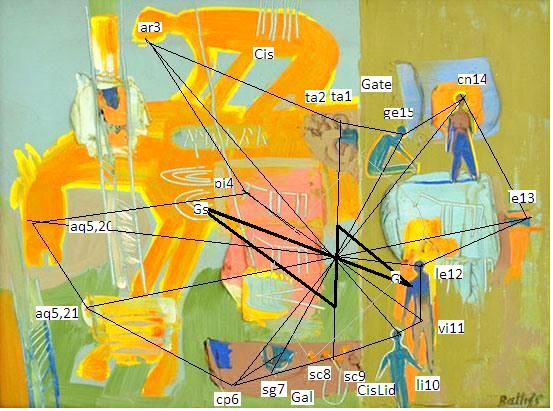
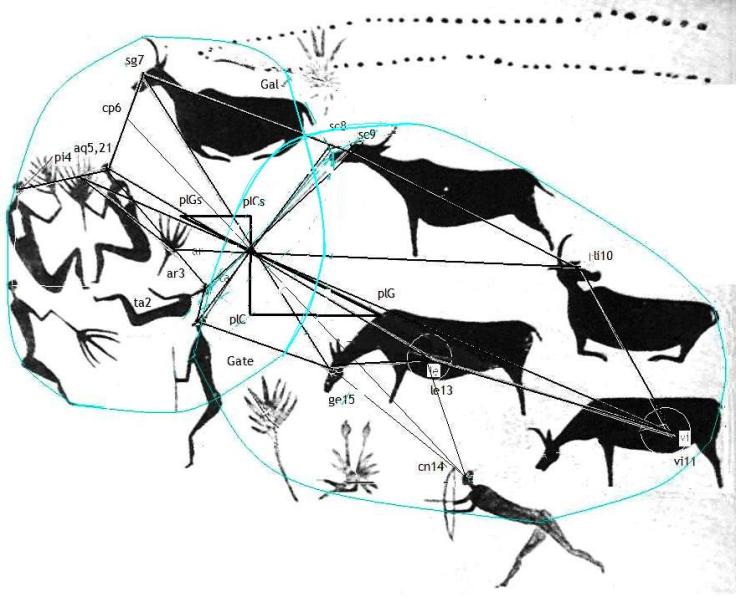
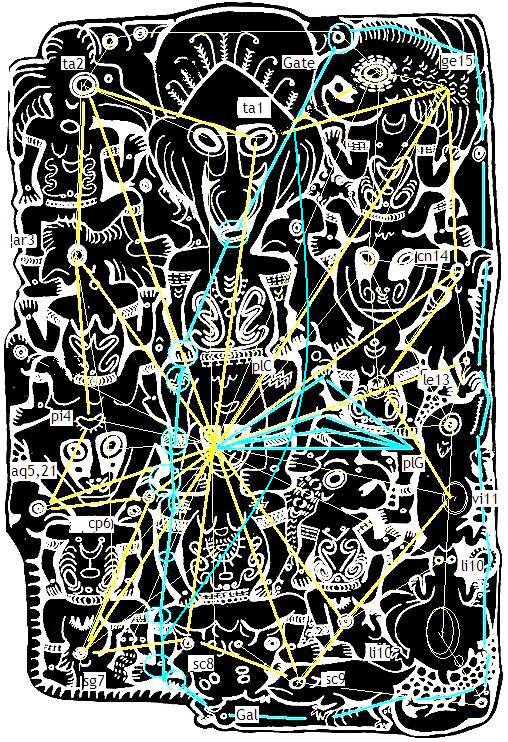
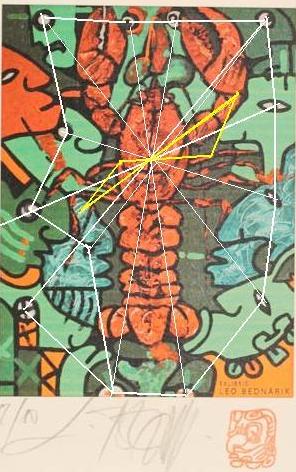
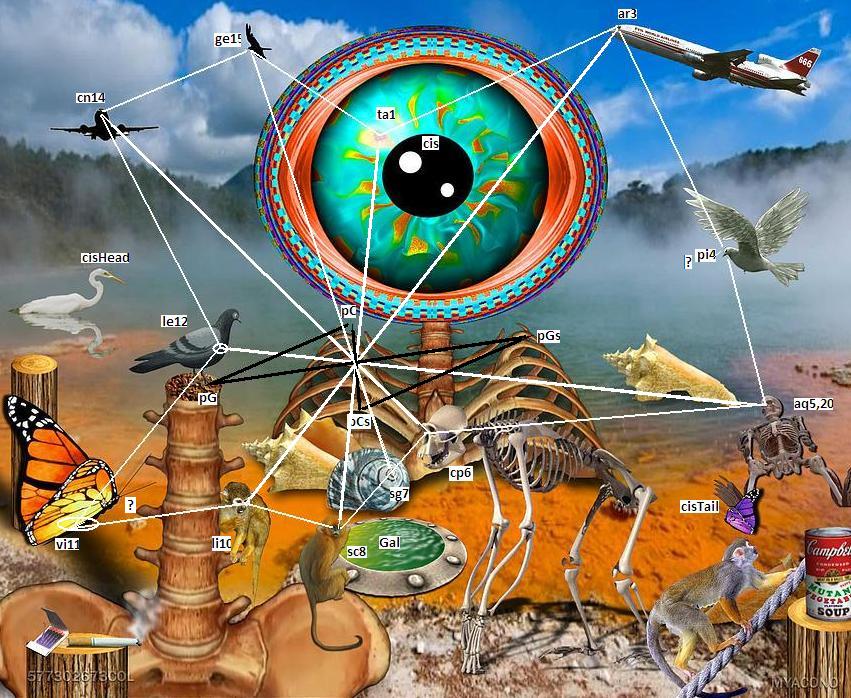
Leave a comment